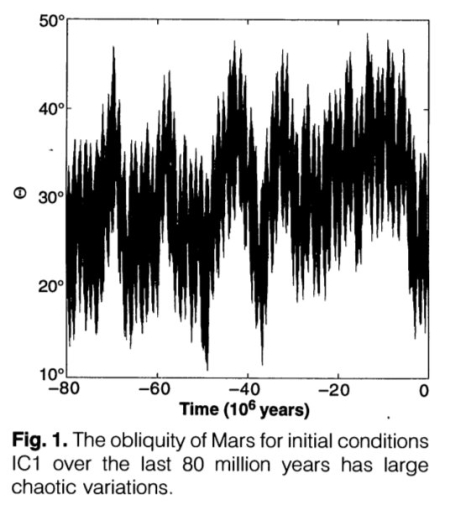The Martian cycles of climate change, as shown in just one crater
Cool image time! The photo to the right, rotated, cropped, reduced, and enhanced to post here, was taken on September 2, 2022 by the high resolution camera on Mars Reconnaissance Orbiter (MRO). The science team titled this picture “Gullies with Terminal Ridges on Glacial Crater Fill,” a title that in one phrase encapsulates everything we see here of this unnamed 8-mile-wide crater’s western rim and interior.
The crater is located at 46 degrees south latitude inside the much larger 145-mile-wide Kepler Crater, and about 1,500 miles east of Hellas Basin in a region where a lot of glacial ice is found. A context camera image taken in July 2020 shows the entire crater floor apparently covered with glacial fill that on the edges appears to be eroding away.
Today’s high resolution photo focused on the western part of the crater, where that eroding edge was instead replaced by a meandering ridge reminiscent of a moraine. The gullies on the interior slope to the west, as well as the parallel north-south cracks, suggest that debris falling and sliding down from that rim had pushed up against this glacial ice and created that ridge.
There is a lot more to this geology however.

The graph comes from this paper [pdf], and shows the shift of Mars’
rotational tilt, or obliquity, for the past 80 million years.
Note the parallel meandering glacial lines to the east of the meandering ridge. Each tells us that the glacial ice that fills this crater is likely made of many layers, with the youngest layers on top and the smallest.
Scientists presently theorize that these layers show the cyclical climate patterns of Mars, caused by the large shifts in the planet’s obliquity, or its tilt along its rotational axis, ranging from 11 to 60 degrees. The graph to the right shows the shifts in Mars’ obliquity over the past 80 million years. As you can see, the shifts have been many, allowing for many such ice layers to grow and shrink in this crater.
Presently Mars is tilted 25 degrees, similar to Earth’s 23 degrees. At this tilt the glaciers are inactive, neither growing or shrinking. When that tilt is high, more than 45 degrees, the mid-latitudes are colder than the poles, and water ice sublimates away from the poles to fall as snow in the mid-latitudes and cause active glaciers to grow. When that obliquity is low, less than 20 degrees, the mid-latitudes are warmer than the poles and those glaciers shrink.
The terraced pattern of the layers however suggests another trend, which is that with each growth period the newest layer on top could not grow as large, further suggesting that the overall available water on Mars was decreasing. This trend, which is seen in many places on Mars, fits with other data, which says Mars once had a lot more water and a thicker atmosphere. Because of its thin gravity it is thought that much of that water and atmosphere over time has escaped into space.
At the same time, Mars is not a dry desert, but an icy one. Though a lot of water has likely been lost, much remains in the ice and glaciers seen routinely at latitudes higher than 30 degrees.
On Christmas Eve 1968 three Americans became the first humans to visit another world. What they did to celebrate was unexpected and profound, and will be remembered throughout all human history. Genesis: the Story of Apollo 8, Robert Zimmerman's classic history of humanity's first journey to another world, tells that story, and it is now available as both an ebook and an audiobook, both with a foreword by Valerie Anders and a new introduction by Robert Zimmerman.
The print edition can be purchased at Amazon or from any other book seller. If you want an autographed copy the price is $60 for the hardback and $45 for the paperback, plus $8 shipping for each. Go here for purchasing details. The ebook is available everywhere for $5.99 (before discount) at amazon, or direct from my ebook publisher, ebookit. If you buy it from ebookit you don't support the big tech companies and the author gets a bigger cut much sooner.
The audiobook is also available at all these vendors, and is also free with a 30-day trial membership to Audible.
"Not simply about one mission, [Genesis] is also the history of America's quest for the moon... Zimmerman has done a masterful job of tying disparate events together into a solid account of one of America's greatest human triumphs."--San Antonio Express-News
Cool image time! The photo to the right, rotated, cropped, reduced, and enhanced to post here, was taken on September 2, 2022 by the high resolution camera on Mars Reconnaissance Orbiter (MRO). The science team titled this picture “Gullies with Terminal Ridges on Glacial Crater Fill,” a title that in one phrase encapsulates everything we see here of this unnamed 8-mile-wide crater’s western rim and interior.
The crater is located at 46 degrees south latitude inside the much larger 145-mile-wide Kepler Crater, and about 1,500 miles east of Hellas Basin in a region where a lot of glacial ice is found. A context camera image taken in July 2020 shows the entire crater floor apparently covered with glacial fill that on the edges appears to be eroding away.
Today’s high resolution photo focused on the western part of the crater, where that eroding edge was instead replaced by a meandering ridge reminiscent of a moraine. The gullies on the interior slope to the west, as well as the parallel north-south cracks, suggest that debris falling and sliding down from that rim had pushed up against this glacial ice and created that ridge.
There is a lot more to this geology however.

The graph comes from this paper [pdf], and shows the shift of Mars’
rotational tilt, or obliquity, for the past 80 million years.
Note the parallel meandering glacial lines to the east of the meandering ridge. Each tells us that the glacial ice that fills this crater is likely made of many layers, with the youngest layers on top and the smallest.
Scientists presently theorize that these layers show the cyclical climate patterns of Mars, caused by the large shifts in the planet’s obliquity, or its tilt along its rotational axis, ranging from 11 to 60 degrees. The graph to the right shows the shifts in Mars’ obliquity over the past 80 million years. As you can see, the shifts have been many, allowing for many such ice layers to grow and shrink in this crater.
Presently Mars is tilted 25 degrees, similar to Earth’s 23 degrees. At this tilt the glaciers are inactive, neither growing or shrinking. When that tilt is high, more than 45 degrees, the mid-latitudes are colder than the poles, and water ice sublimates away from the poles to fall as snow in the mid-latitudes and cause active glaciers to grow. When that obliquity is low, less than 20 degrees, the mid-latitudes are warmer than the poles and those glaciers shrink.
The terraced pattern of the layers however suggests another trend, which is that with each growth period the newest layer on top could not grow as large, further suggesting that the overall available water on Mars was decreasing. This trend, which is seen in many places on Mars, fits with other data, which says Mars once had a lot more water and a thicker atmosphere. Because of its thin gravity it is thought that much of that water and atmosphere over time has escaped into space.
At the same time, Mars is not a dry desert, but an icy one. Though a lot of water has likely been lost, much remains in the ice and glaciers seen routinely at latitudes higher than 30 degrees.
On Christmas Eve 1968 three Americans became the first humans to visit another world. What they did to celebrate was unexpected and profound, and will be remembered throughout all human history. Genesis: the Story of Apollo 8, Robert Zimmerman's classic history of humanity's first journey to another world, tells that story, and it is now available as both an ebook and an audiobook, both with a foreword by Valerie Anders and a new introduction by Robert Zimmerman.
The print edition can be purchased at Amazon or from any other book seller. If you want an autographed copy the price is $60 for the hardback and $45 for the paperback, plus $8 shipping for each. Go here for purchasing details. The ebook is available everywhere for $5.99 (before discount) at amazon, or direct from my ebook publisher, ebookit. If you buy it from ebookit you don't support the big tech companies and the author gets a bigger cut much sooner.
The audiobook is also available at all these vendors, and is also free with a 30-day trial membership to Audible.
"Not simply about one mission, [Genesis] is also the history of America's quest for the moon... Zimmerman has done a masterful job of tying disparate events together into a solid account of one of America's greatest human triumphs."--San Antonio Express-News


